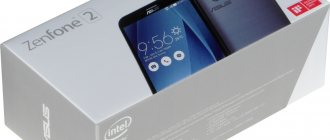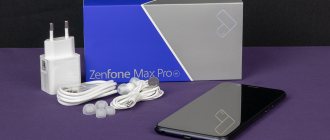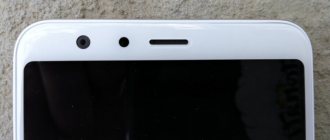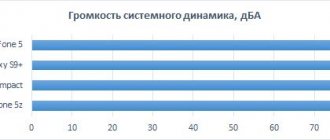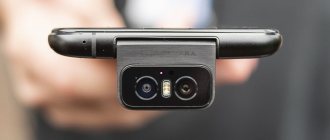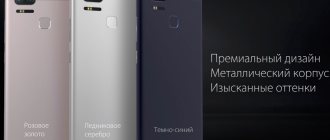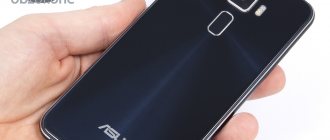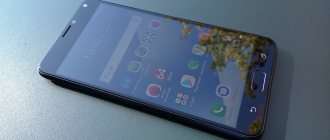The ASUS Zenfone 5 Lite smartphone that we are studying today is a completely new model. It was presented at the main mobile exhibition in Barcelona, and was one of the first to arrive in Russia. What interested us in this smartphone?
Firstly, a fairly powerful filling, and secondly, maximum opportunities for those who like to take pictures on a mobile phone in general and make “crossbows” in particular. To do this, ASUS ZenFone 5 Lite has four cameras, including modules with the widest possible viewing angle - so that everything fits into the frame!
And thirdly, it was interesting to compare ASUS ZenFone 5 Lite with its predecessor, ASUS ZenFone 4, which we wrote about recently.
When comparing the ASUS ZenFone 5 Lite with its predecessor, it is very clear how quickly the rules of the game are changing in the smartphone industry. The new model has another front camera and a display of new proportions, but at the same time it had to sacrifice something.
With what?
Appearance and general impressions of ASUS ZenFone 5 Lite
The new smartphone received a display with an aspect ratio of 18:9, and this caused conflicting sensations during the test. Visually, the proportions of the eye body are not pleasing. The phone is very elongated in height, but remains narrow; holding it with one hand and scrolling through it has become uncomfortable.
The changed proportions also affected the ergonomics. The upper part is overweight, and the smartphone tries to slip out of your hand. If you're already used to holding your phone with both hands, this won't be a problem, but if you're moving from a smartphone with more familiar and standard proportions, be sure to turn it around in your hands properly before purchasing.
The on-screen keyboard is small and awkward, even with a six-inch screen, and when turned to landscape mode, the typing field narrows to a ridiculous height. But there is a lot of space left for everything else, and perhaps for those who like to scroll through Instagram feeds or other social networks, this will be more of a plus than a minus.
Case ASUS ZenFone 5 Lite
The build quality of ASUS ZenFone 5 Lite is very good, as is its predecessor ASUS ZenFone 4. The body remains glass, it looks impressive and creates a pleasant feeling of a monolithic device.
The side ends are now matte, milky white. The ASUS ZenFone 4 had a silver bezel, similar to aluminum, and looked more catchy, although it was also made of plastic. However, the matte version gives hope that it will peel and scratch less with prolonged use.
At the top of the device there are two cameras (main and wide-angle), a flash LED, a speaker, an LED indicator, and a proximity/light sensor.
Another fashion trend in ASUS ZenFone 5 Lite: the buttons have become virtual, and this is not a good idea. Visually it’s beautiful, but it would be more convenient with buttons. There was enough space left under the screen that buttons could have been placed, but no.
Virtual buttons are called up by swiping from bottom to top, and you won’t be able to go back or cancel something with one touch. Yes, you can make them always visible, but for most applications they are more likely to be a hindrance than a help.
At the top end there is a headset jack and a noise-canceling microphone. For some reason the 3.5 mm plug moved from the bottom to the top, but thanks for that, they could have removed it completely. On the bottom edge there are traditionally grilles with a speaker and microphone and a microUSB connector.
In the absence of a physical button on the bottom, the fingerprint sensor has moved to the rear panel. The sensor works well, but there is a feeling that the previous model worked faster and more reliably. It is worth noting that the ASUS ZenFone 5 Lite sensor also has problems with recognizing wet fingers, although the manufacturer claims that wet hands are not a problem for fingerprint recognition.
Asus Zenfone 5 Lite ZC600KL Smartphone: Review
Dimensions and design
Asus Zenfone 5 Lite ZC600KL is a large smartphone with an elongated display and covered with glass on both sides. It looks good, but we can’t call it original or very beautiful.
The front panel looks casual - with noticeable frames and rounded corners. Somehow, only the dual front camera stands out, but at first it’s not even clear whether these are lenses, or some kind of regular sensors. The rear of the smartphone is more original, especially in red. On the back you can see a double camera; they are oriented vertically and are located in the center of the body and are united by a common rim. Below them is a round fingerprint scanner. The buttons are arranged in a typical way - the power key and volume rocker are on the right.
Dimensions of Asus Zenfone 5 Lite ZC600KL - 160.6 × 76.2 × 7.8, weight - 168 grams. The smartphone is quite thin, but its weight can be assessed as average. In thickness it is comparable to Huawei Honor 9, and in weight - with Huawei P10 Plus. As we said above, the smartphone is covered with glass on both sides - beautiful, but not so practical.
Asus Zenfone 5 Lite ZC600KL can be purchased in three colors - black, white and red.
Screen
Asus Zenfone 5 Lite ZC600KL has a typical fashionable frameless screen. It has a popular “widescreen” aspect ratio of 18:9, a common diagonal of 6 inches and a resolution of Full HD+ (2160x1080 pixels). An IPS matrix is used, it is not yet clear whether there is any kind of protective glass and oleophobic coating. The pixel density is high enough for clear images - 402 per inch. No other interesting details were announced, only the mode of operation with gloves. Most likely, there will be settings for screen color rendering, blue light filters, and so on, as in all Asus smartphones.
Cameras
Asus Zenfone 5 Lite ZC600KL received four cameras at once, two on the front and two on the back. Yes, now this is no longer uncommon; it’s worth remembering at least the four-camera Huawei Honor 9 Lite.
The main rear camera has 16 MP, a mediocre f/2.2 aperture and phase detection autofocus in 0.03 seconds. Additional – wide-angle (120°) and 8 MP. Apparently, as in all similar Asus smartphones, the phone’s cameras do not shoot together and do not help each other, but simply shoot separately. That is, the only advantage of such a duet is the ability to shoot from different viewing angles. Yes, it claims to shoot bokeh, but it’s a software one, which means you shouldn’t expect very good results from it. If we talk about shooting video, the older modification Zenfone 5 Lite ZC600KL will shoot 4K/Ultra-HD video (3840×2160).
The main front camera immediately received 20 MP, an advanced Sony IMX376 sensor, an average f/2.0 aperture and 1 micron pixels. The additional camera is also wide-angle (120°), 8 MP and shoots separately.
Communications
The communications set of Asus Zenfone 5 Lite is not bad, but it depends on the chipset used:
- high-speed and dual-band Wi-Fi a/b/g/n/ac (version on Snapdragon 630)
- simple Wi-Fi b/g/n (version on Snapdragon 430)
- support LTE Cat.13 (400/75 Mbit/s)
- Bluetooth 4.1
- A-GPS
- NFC chip
- FM radio
- compass and gyroscope.
The nicest thing is to see the NFC chip here and the fact that they don’t forget about the radio. It's a little strange that the phone uses the "old" microUSB 2.0 port. But Zenfon 5 light has three separate slots for two SIM cards and a memory card and a separate mini-jack for headphones.
Battery
The smartphone uses a 3300 mAh battery, which is not that much for a 6-inch screen, but quite typical. Other “frameless” models have the same amount, 3200 mAh for the ZTE Blade V9 and the same 3300 mAh for the Oppo F5. That is, here Zenfone 5 Lite is in a normal position, again without any “light” concessions. You can expect it to last for a day and a half of use or more. The manufacturer itself promises up to 30 hours of calls on 3G networks and up to 4 days of music listening (approximately 96 hours). If this is the case, then the autonomy in absentia can be called good. They don’t say anything about support for fast charging, but there is information that the device will come with regular charging at 5V and 2A.
Performance
Asus Zenfone 5 Lite ZC600KL can be purchased in two versions, with different processors, on which performance will depend:
- eight-core Qualcomm Snapdragon 630 (up to 2.2 GHz)
- eight-core Qualcomm Snapdragon 430 (up to 1.4 GHz)
The amount of RAM is either 3 or 4 GB. In the first case, Adreno 508 is responsible for graphics, and in the second, Adreno 505. We met the Snapdragon 630 in the Asus Zenfone 4, which is powerful enough for the vast majority of tasks. From the 430 (Huawei Honor 6A, Nokia 6) you can expect a smooth interface, but not the highest frame rates in demanding games.
Peculiarities
Asus Zenfone 5 Lite ZC600KL launches with Android 7 and its own ZenUI shell. We would rate the latter as functional, but a little redundant and cluttered. The main feature of the model is its strange name, or rather the Lite prefix, which is valid only for the younger version with a simpler chipset. Other features include the trendy facial recognition function (like in the iPhone X or Oppo F5) and wet finger recognition. The latter sounds more interesting and unusual; as a rule, wet fingers are a serious problem for fingerprint scanners.
Memory
The memory capacity of the Zenfone 5 ZC600KL will be 32 or 64 GB. This is already a lot and will last you for a long time, but if necessary, you can expand the storage using a memory card. It is stated that cards with capacities up to 2 TB are supported - it is not clear where and when these can be bought, while they are not even on sale. Nevertheless, it’s nice that there is a separate third slot for it.
Price
The smartphone will go on sale in March 2020, the price will be 22,000 rubles. It looks a little expensive, but noticeably cheaper than last year’s “main” Zenfone 4 ZE554KL, which cost 30-33 thousand rubles at the start of sales.
Display ASUS ZenFone 5 Lite
The smartphone has excellent quality and good resolution. The anti-glare display is quite readable even in bright sunlight and is very responsive.
Automatic brightness adjustment is a little late and a little erroneous, so I ended up turning this option off. Like the ASUS ZenFone 4, the new model's settings include a blue filter for those who are careful with their eyes, and it still works well. But the utility for managing screen color parameters has, unfortunately, been removed, which is a pity. This was a useful feature that allowed you to play with colors in different modes of using your smartphone.
ASUS ZenFone 5 Lite performance and battery
The hardware of ASUS ZenFone 5 Lite is not bad: 8-core Snapdragon 630, 4 GB of RAM and 64 GB of internal memory. His predecessor had exactly the same one. These are not top-end specifications, but they are more than enough for comfortable work. All operations occur very quickly, there are no delays or freezes. The case itself does not heat up during normal use.
Separately, I would like to mention that in ASUS ZenFone 5 Lite, unlike most modern smartphones, the manufacturer did not save on slots. The smartphone uses a regular slot, not a combined one, for two SIM cards and microSD memory cards with a capacity of up to 2 TB. Both SIM card slots support 4G LTE, however, as the manufacturer warns, only one of the SIM cards can connect to the 3G network, and not both at the same time.
The battery of the ASUS ZenFone 5 Lite is quite capacious, and the smartphone is well balanced, so the charge lasts for a long time: I had 60% charge left in a day of normal, non-extreme use. But there is also a significant drawback - the smartphone does not have a fast charging function.
Review of ASUS Zenfone 5 Lite (ZC600KL): the younger brother of the new flagship
Table of contents
- Introduction
- Specifications
- Packaging and equipment
- Appearance and design
- Display
- Hardware platform and performance
- Software and firmware
- Multimedia
- Wireless Interfaces and Communications
- File system
- Battery life
- Camera
- Comparison with competitors
- Conclusion
- Additional photos
Introduction
]ASUS[/anchor] pays a lot of attention to the development of smartphones, and these efforts are bearing fruit.
The new ASUS Zenfone 5 line attracts attention with its cute design and good performance. At the same time, it is officially supplied to the Russian market and is provided with a manufacturer’s warranty. Recently, a presentation of the new generation Zenfone took place in Moscow, and readers are already familiar with the review of the flagship of the line - ASUS Zenfone 5. Today the object of our attention is the younger model, called ASUS Zenfone 5 Lite.
The manufacturer positions the new product as an excellent solution for young people who strive to keep up with the times, preserving the memory of vivid impressions and sharing them with friends. For this, there are four cameras (including two front ones with different viewing angles, which will delight selfie fans) and corresponding hardware with support for all modern technologies, including NFC.
As usual, we’ll start with the technical characteristics of the model.
announcements and advertising
2080 Super Gigabyte Gaming OC for 60 rubles.
Compeo.ru - the right comp store without any tricks
RTX 2060 becomes cheaper before the arrival of 3xxx
Ryzen 4000
series included in computers already in Citylink
The price of MSI RTX 2070 has collapsed after the announcement of RTX 3xxx
Core i9 10 series is half the price of the same 9 series
The price of memory has been halved in Regard - it’s more expensive everywhere
Specifications ASUS Zenfone 5 Lite (ZC600KL)
| Model | ASUS Zenfone 5 Lite (ZC600KL) | ASUS ZenFone 5 (ZE620KL) |
| CPU | Qualcomm Snapdragon 630, 8 x 2.2 GHz, Cortex-A53 | Qualcomm Snapdragon 636, 8 x 1.8 GHz, Kryo 260 |
| Video processor | Adreno 508 | Adreno 509 |
| operating system | Android 7.1 (8.0) + ZenUI 5.0 | Android 8.0 + ZenUI 5.0 |
| Memory, GB | 4 RAM; 64 ROM | 4 RAM; 64 ROM |
| Screen | 6.0″ IPS, 2160 x 1080 | 6.2″, IPS, 2246 x 1080 |
| Cameras, Mpix | Front 20.0 + 8.0; Basic 16.0 + 8.0 | Front 8.0, Main 12.0 + 8.0 |
| Net | GSM; WCDMA; LTE | GSM; WCDMA; LTE |
| Number of SIM cards, pcs. | 2, Nano-SIM | 2, Nano-SIM |
| MicroSD support | Yes | Yes |
| Wireless interfaces | Wi-Fi; Bluetooth; NFC | Wi-Fi; Bluetooth; NFC |
| GPS/aGPS/GLONASS | Yes Yes Yes | Yes Yes Yes |
| Battery, mAh | 3 300 | 3 300 |
| Dimensions, mm | 160.6 x 76.2 x 7.8 | 153.0 x 75.6 x 7.7 |
| Weight, g | 168 | 155 |
| price, rub. | 21 990* | ~27 990* |
*Price recommended by the manufacturer.
Compared to the older version, we note less top-end characteristics, but the hero of the review does not try to look like a flagship. But for the middle class, in which the new product is initially positioned, such equipment is quite competitive.
Packaging and equipment ASUS Zenfone 5 Lite (ZC600KL)
The material for the box was thick white cardboard, and the lid was made in the form of a cover into which the box was pushed. There are no complaints about the quality of execution - all elements are precisely adjusted to each other. You don't have to worry about the safety of the contents.
The name of the device model is indicated on the front side.
The reverse side is occupied by service information and identification data of a specific instance.
Inside the box we find a cover with documentation and a protective case. The smartphone itself is located below and is packaged in a matte protective cover.
The protective case is made of transparent silicone and is firmly fixed to the body of the device, protecting it from minor damage during operation. Let us add that the smartphone remains attractive in appearance, since the case is almost invisible.
The delivery set is hidden at the bottom of the box.
It includes:
- Power adapter;
- USB-microUSB cable;
- Wired stereo headset;
- Silicone Case;
- A key-clip for removing the SIM card slot;
- Documentation.
There are no surprises here, although the presence of a case and a headset is a plus.
Cameras and shooting quality of ASUS ZenFone 5 Lite
It is clearly noticeable that the camera and everything related to shooting is one of the main features of the device. There are a lot of cameras in ASUS ZenFone 5 Lite, one description can get boring:
— Front camera with a viewing angle of 85.5 degrees, a resolution of 20 megapixels, an f/2.0 aperture and an equivalent focal length of 23.4 mm.
— Front wide-angle camera with a viewing angle of 120 degrees, a resolution of 8 megapixels and an equivalent focal length of 12.5 mm.
— Main camera with a viewing angle of 80 degrees, 16 megapixels, f/2.2 aperture and an equivalent focal length of 25.8 mm.
— Wide-angle main camera with a viewing angle of 120 degrees and an equivalent focal length of 12.5 mm.
The main front camera pleases with fast focusing (0.3 seconds) and portrait mode. The background blur function (bokeh effect) works very well. The flash for the front cameras produces light with a rather cold tint, but in poor lighting conditions it is very helpful.
The second, wide-angle front camera is very useful if you like to take group selfies or just want more background for yourself, beautiful. But there is also a side effect: without using a selfie stick, the photos turn out to be quite funny: no matter how I tried, the camera grabs your hand, pulls it out funny, and it’s absolutely impossible to do anything about it.
To see the original photo, just click on it
This is what a selfie looks like taken in normal mode
And so - a crossbow on a wide-angle camera
The dual main camera of ASUS ZenFone 5 Lite is now located vertically and the lenses protrude from the body. They do not protrude much, the device lies on the table, almost without swaying. Still, the location of ASUS ZenFone 4 looks more successful.
When shooting in automatic mode, it is very noticeable that different cameras use different algorithms for determining the white point and focusing. This applies to both the front camera and the main one. In both cases, wide-angle cameras make mistakes in determining white balance, and this is noticeable in the photographs.
This photo was taken with the main camera, standard mode
And this one using the wide-angle lens of the main camera
It seems that when shooting with a wide-angle camera, some kind of filter is set by default to enhance color saturation, and it is greatly overdone.
Example video shot on ASUS Zenfone 5 Lite
ZenFone 5 Lite camera review
The smartphone received four cameras at once - two front and two main modules, so now the Bokeh effect can be obtained even in selfies. The main camera uses a lens with a resolution of 16 megapixels, a viewing angle of 80 degrees and an aperture of f/2.2. In addition to it, there is an 8 MP wide-angle sensor.
PixelMaster software provides access to a huge number of settings, including manual shooting with the ability to set shutter speed up to 32 seconds. There is a facial skin enhancement mode that visually smoothes out imperfections. It can correct the size of your cheeks, enlarge your eyes and brighten your skin, making you look more beautiful in photographs. There is a “Super Resolution” mode, which allows you to take a picture with a resolution of 65 megapixels.
Example photo on ZenFone 5
The selfie camera includes a main Sony IMX376 module with a resolution of 20.1 megapixels and an additional 8 megapixels. In the first case, the viewing angle is 85.5 degrees, and in the second 120, which allows you to capture more objects in the frame. This makes the smartphone an ideal choice for group selfies.
The sensor has a wide dynamic range, which virtually eliminates the need to shoot in HDR mode. The latter will be useful only in backlight and it must be said that it effectively copes with its task, drawing out the formed shadows.
Photos taken at night are not of good quality. You can notice a huge amount of noise on them. But this is with automatic settings, and it is better to use manual ones, setting the optimal ISO and shutter speed parameters. In this case, it will still be possible to get a decent shot even at night. The flash can operate in pulse mode or glow continuously. The last option will be advantageous, since the lighting is softer.
But during the day you can get good photos, but again for this purpose it is better to experiment with manual settings; the automatic ones still often miss, which is why the quality of the photo suffers. The same applies to the front camera, but, unfortunately, there are no manual settings for it.
The video is recorded in a maximum resolution of 4K, which is already good. Below you can watch the video in FullHD quality at 30 fps, which was recorded in the evening, when there was still enough lighting, but nevertheless there was a lot of noise. There is optical stabilization and the ability to record short slow-mo (their duration does not exceed 5 seconds). ASUS ZenFone 5 Lite 2020 review showed that perhaps the situation will be corrected in further updates, but now it is far from ideal.
]
Conclusion
ASUS ZenFone 5 Lite turned out to be a very successful device, which offers a gorgeous 18:9 screen, a separate slot for a flash drive, an NFC chip, an optimal amount of memory and a good processor. The design and autonomy also leave behind positive emotions; there are only complaints regarding the camera. There is a lot of noise when shooting in automatic mode.
Advantages:
- Large screen 18:9;
- Dedicated slot for microSD;
- NFC;
- Good autonomy results;
- Excellent filling for the price.
Flaws:
- Photo quality is not above average;
- MicroUSB port and lack of fast charging.
Comments for the Cackl e
You might be interested in:
Asus Zenfone Selfie - the perfect gadget for selfie lovers
Asus Zenfone 4 Max - the main feature is the capacious battery
Asus Zenfone Go is the most affordable in the new line
Review of the Asus Zenfone 2 Laser smartphone
ASUS ZenFone 4 Pro - review of the first Asus flagship with an elongated display and a top-end Snapdragon processor
ASUS ZenFone Max Plus review
ASUS ASUS ZenFone 5 Lite with 18:9 screen with two main cameras with two front cameras with optical stabilization with a mid-priced Snapdragon processor
Face recognition in ASUS ZenFone 5 Lite
A separate surprise prepared in ASUS ZenFone 5 Lite is face recognition. This is another fashion trend picked up in the new model.
The face unlock function is connected as an addition to other authentication options: fingerprint scanner and password. Reading the face occurs in a second, but things are not so good with unlocking.
When I tried to unlock the phone at the very place where recognition was configured, everything went fine. But as soon as we moved to slightly worse lighting conditions, the recognition quality dropped sharply. I just walked away from the window of the room into the corridor; the day was clear and sunny. It was light in the apartment, but the sensor still worked every once in a while. In complete darkness, recognition, as one would expect, does not work at all.
However, facial recognition along with a fingerprint scanner is a very convenient tandem. On a lit street, when your hands are in gloves, facial recognition will work, there is not enough light, we will use a fingerprint. Well, if your hands are wet, the easiest way is to enter your PIN code.
Platform
ASUS ZenFone 5 Lite uses the current mid-class platform. The smartphone is equipped with an 8-core Qualcomm Snapdragon 630 processor with gr. The 14-nanometer chip has proven itself very well in this segment. The SoC offers a good combination of performance and efficiency.
ASUS ZenFone 5 Lite also uses a win-win combination of RAM and storage memory for its class - 4/64 GB. In our market, smartphones will be offered on exactly this platform, although in principle, the ASUS ZenFone 5 Lite can also use a less powerful Snapdragon 430 chip in combination with 3 GB of RAM and a 32 GB internal storage. In both cases, data storage can be expanded with a microSD memory card of up to 2 TB.
Separately, we note the presence of Wi-Fi 802.11ac, as well as full support for NFC, which is not so often found in devices of this class.
ASUS ZenFone 5 Lite - buy or not?
ASUS ZenFone 5 Lite turned out to be successful. Good camera, good screen, good hardware. And good price. Being in many ways more relevant than ASUS ZenFone 4, it costs less - 22,000 versus 27,000 rubles.
If you are not bothered by the proportions of the device, and you are willing to save a little, even if you lose fast charging, a USB-C connector and some other little things, perhaps this is your option.
Advantages:
- build quality, impressive glass case;
- the ability to install two SIM cards and a memory card at the same time;
- good and contrasting display;
- dual cameras with wide-angle lenses;
Flaws:
- outdated microUSB connector instead of USB-C and lack of fast charging;
- lack of dust and moisture protection;
- low speaker volume.
Performance
The smartphone has a decent platform for its class, so there are no special performance issues during normal use of the device.
The 8-core Snapdragon 630 copes well with all typical tasks, and 4 GB of RAM also helps here.
Reminders that we are not dealing with a flagship may appear in heavy games, where the Adreno 508 does not always cope perfectly with high graphics quality settings. The increased screen resolution also makes itself felt here, which also creates additional load on the built-in GPU. However, the ASUS ZenFone 5 Lite handles most projects without much difficulty.
During sessions of resource-intensive applications, the upper part of the device heats up minimally, but this does not cause any discomfort.
Specifications ASUS ZenFone 5 Lite
- Display size and type: 6-inch, 1080*2160 pixels, LCD (IPS), aspect ratio 18:9 (2:1) Gorilla Glass with rounded edges (2.5D);
- Processor: Qualcomm Snapdragon 630, 8 cores (4x2.2 GHz, 4x1.85 GHz);
- Graphics accelerator: Adreno 508;
- Internal memory: 64 GB;
- RAM: 4 GB;
- Memory expansion: microSD (up to 2TB);
- Number of slots: 2 nano SIM + 1 microSD)
- Main camera: 16 MP, f/2.2 + 8 MP, f/2.4;
- Front camera: 20 MP, f/2.0 + 8 MP, f/2.4
- Maximum video resolution: 4K – 3840×2160
- Operating system: Android 7.1.1 + ZenUI 4.5;
- Connectors: Micro-USB, 3.5 mm headphone jack;
- Audio MP3, AAC, WAV, WMA, FM radio;
- Communication: GSM 850/900/1800/1900, 3G, 4G LTE, VoLTE;
- Communications: Wi-Fi 802.11b/g/n/ac, 2.4/5 GHz, MU-MIMO, Bluetooth 5.0, NFC;
- Navigation: GPS, GLONASS, Beidou, Galileo, QZSS, SBAS;
- Built-in sensors: acceleration, electronic compass, gyroscope, proximity sensor, light sensor, Hall sensor, fingerprint reading;
- Battery capacity 3300 mAh;
- Dimensions (WxHxT): 76×160.5×7.7 mm;
- Weight: 168.3 g;
- Device color as tested: Moonlight White;
- Cost at the time of testing: 21,990 rubles.
Review of ASUS ZenFone 5 Lite 2020 (ZC600KL)
The ZenFone 5 family of smartphones has dual cameras on both the front and back, and the screen has a now fashionable aspect ratio of 18:9 (2:1). Even the younger version with the Lite prefix can boast of such a set, which came to us for testing. The new product is built on the same system-on-a-chip as the basic model ZenFone 4, which we tested not so long ago, but is not used normal, but a wide display with rounded corners. There is also an additional wide-angle front camera (there are also two rear cameras, like its predecessor) and a front flash, which ASUS has already used in ZenFone 4 Max. It’s also worth noting the microUSB connector, which was hard to expect in a 2020 smartphone. Apparently, the manufacturer is thus separating older and younger modifications of the updated ZenFone 5 family.
Specifications
| Display size and type | 6-inch, 1080*2160 pixels, LCD (IPS) |
| CPU | Qualcomm Snapdragon 630, 8 cores (4x2.2 GHz, 4x1.85 GHz) |
| Graphics accelerator | Adreno 508 |
| Built-in memory, GB | 64 |
| RAM, GB | 4 |
| Memory expansion | microSD |
| Number of SIM cards | 2 |
| 2G communication standards | 850, 900, 1800, 1900 |
| 3G communication standards | 800, 850, 900, 1700/2100, 1900, 2100 |
| 4G communication standards | 700, 800, 850, 900 1800, 1900, 2100, 2300, 2500, 2600 |
| WiFi | Wi-Fi802.11b/g/n/ac, 2.4/5 GHz, MU-MIMO |
| Bluetooth | v5.0 |
| NFC | Eat |
| IrDA | No |
| USB connector | microUSB |
| Audio jack | TRRS (mini-jack 3.5 mm) |
| FM radio | No |
| Fingerprint's scanner | Eat |
| Navigation | GPS, GLONASS, Beidou, Galileo, QZSS, SBAS |
| Built-in sensors | acceleration sensor, electronic compass, gyroscope, proximity sensor, light sensor, Hall sensor |
| Rear camera | Main: 16 MP, f/2.2; Additional: 8 MP, f/2.4 |
| Front-camera | Main: Sony IMX376, 20 MP, f/2.0; Additional: 8 MP, f/2.4 |
| operating system | Android 7.1.1 + ZenUI 4.0 in test sample Android 8 + ZenUI 5.0 in commercial samples |
| Protection class | No |
| Battery | 3300 mAh |
| Dimensions, mm | 160,3*76,9*8,7 |
| Weight, gram | 168,3 |
Appearance and ease of use
If the fourth generation was strikingly different from the third, then ZenFone 5 Lite, on the contrary, is extremely similar to its predecessor. Although, of course, there are differences. The first thing that catches your eye is the elongated display with an aspect ratio of 18:9 (2:1). You also can’t help but notice a pair of cameras and a flash in the frontal plane. However, the latter was already available in the ASUS ZenFone 4 Max version. But what attracts most attention is the abandonment of dedicated touch control keys, as well as the transfer of the fingerprint reading sensor to the back side. Of course, this decision is directly related to the installation of an 18:9 screen.
We received a pre-sale sample for testing, so there was no hope for special build quality. Still, commercial versions often differ from demo samples in higher quality. But the smartphone was a pleasant surprise - the build quality is excellent, and when trying to twist the wide and thin smartphone only barely noticeably gives in, but at the same time it does not make any cracking or squeaking noises. The back and front panels are made of glass with an oleophobic coating. The ends of the device are plastic. The lining on the chamfered ends looks like metal, but in fact it is the same plastic, but with a nickel-plated surface.
At the front, above the display, there are a pair of cameras, a system speaker, an LED indicator, a front-facing flash, and a proximity/light sensor.
On the back side you can see a pair of cameras, the block of which is slightly raised above the main surface, a flash, as well as a round fingerprint sensor. The diameter of the latter is about 9 mm, which is not always enough. Although if we compare it with ASUS ZenFone 3, which also had a sensor on the back, then the new product’s fingerprint sensor is still more convenient. There are no problems with the reliability of the sensor, but due to its small size, aiming at it is not very convenient at first.
On the right side surface there is a double volume key, as well as a lock key (perhaps in the final images it will be white, not silver). On the left side, only a tray for simultaneous installation of a pair of SIM-format nanoSIM, as well as a microSD data carrier, is noticeable.
On top there is a standard analog audio jack, as well as a microphone. Two decorative grilles are visible from below, but the speaker is hidden only under one of them. A microUSB connector is installed in the center, which is immediately worth writing down as a disadvantage of the device. Of course, this connector was installed only to separate ASUS ZenFone 5 Lite from the older model, but in 2020 such an approach is no longer appropriate. For example, all modern Sony smartphones are equipped with a USB Type-C connector, including representatives of the younger Sony Xperia L line.
Software
The smartphone runs Android 7.1.1 OS with ASUS ZenUI 4.0 proprietary add-on. In general, everything is the same as in the ZenFone 4 series smartphones. The features of ASUS ZenUI 4.0 can be found in the ASUS ZenFone 4 (ZE554KL) review. The final versions of ZenFone 5 Lite will receive a firmware update based on Android 8 (Oreo) and ZenUI 5.0 shell
Display
The smartphone has an IPS matrix with a diagonal of 6 inches and a resolution of 1080*2160 pixels, that is, with an aspect ratio of 18:9 (2:1), which is now actively gaining popularity. From a subjective point of view, this aspect ratio in the case of mobile devices is extremely convenient, because with a body width similar to that of 5.2…5.5-inch models, the user receives a much larger screen area. This is convenient both when viewing web pages in portrait orientation and when watching wide-screen movies. 18:9 is a compromise between the classic 16:9 ratio and the cinematic 21:9 ratio. Both yours and ours. In addition to the still unusual ratio, the smartphone boasts rounded corners, like, for example, the Samsung Galaxy A8/A8+. It looks interesting and organic against the background of the rounded corners of the body.
The display is equipped with an anti-glare layer and supports up to 10 simultaneous touches, which is now standard. When setting the maximum backlight level, the brightness of the white field is 461.68 cd/sq.m. This is a good result, but not a record one. But more importantly, the brightness of the black field is only 0.28 cd/sq.m., that is, the static contrast is 1649:1. But this is already a record, and the gap from all competitors is simply huge. The color gamut is much wider than the standard sRGB color space, and almost completely covers it. But, unfortunately, due to the significantly elevated color temperature, the accuracy of color display is low; of course, because of this, the color balance, where the blue component predominates, also suffers. Unfortunately, the display settings do not provide the ability to change the color temperature.
This slideshow requires JavaScript.
Sound
The smartphone uses two speakers - conversational and system. They are not trained to work in pairs. There are no complaints about the conversational speaker - the interlocutor can be heard well, the sound is clear and loud. But the system speaker is not particularly pleasing. There are no obvious defects such as crackling, squeaking or hissing; when the volume is set to the maximum level, the speaker does not choke, but the sound is flat and inexpressive. The lack of bass in the system dynamics of the smartphone is not surprising, but the poorly developed high-frequency range should be considered a disadvantage. The volume level of the system speaker is average, but already on the verge of a foul. When playing a test sine wave with a frequency of 1 kHz at a distance of 1 meter from the smartphone, a value of 71.6 dBA was recorded. In general, in order not to miss an incoming call in a noisy place, you need to choose a noticeable melody.
The analog audio output level is low. When playing the test signal when operating at a load of 32 Ohms, a value of 184 mV was recorded. When connecting a 16 Ohm load – 150.2 mV. In general, for normal listening to music you need headphones with high sensitivity. Sound quality was assessed using the RightMark Audio Analyzer program and a Creative E-MU 0204 USB sound card.
General results RMAA , 24 bit/48 kHz
| Frequency response unevenness (in the range 40 Hz – 15 kHz), dB | +0.03, -0.12 | Great |
| Noise level, dB (A) | -91.6 | Very good |
| Dynamic range, dB (A) | 84.9 | Fine |
| Harmonic distortion, % | 0.012 | Fine |
| Harmonic distortion + noise, dB(A) | -79.3 | Average |
| Intermodulation distortion + noise, % | 0.017 | Very good |
| Interpenetration of channels, dB | -90.6 | Great |
| Intermodulation at 10 kHz, % | 0.018 | Very good |
| Overall rating | Very good |
Performance
ASUS ZenFone 5 Lite is based on the same system on a chip as ASUS ZenFone 4 – Qualcomm Snapdragon 630. This SoC is manufactured using the 14 nm FinFET LPP process. It is based on 8 Cortex A-53 cores, half of which operate at frequencies up to 2.2 GHz, and another 4 cores – up to 1.85 GHz. The video subsystem is based on Adreno 508. Dual-channel 4 GB LPDDR4 memory operates at a frequency of 1333 MHz. System performance was measured in synthetic PCMark, 3DMark, Geekbench 4, AnTuTu v7. Memory speed was assessed using the AndroBench application. Testing was also carried out in cross-platform javascript tests (Mozilla Kraken JavaScript and SunSpider). The results of these tests significantly depend on the browser used, so Google Chrome was used as the most common. The following smartphones were chosen as opponents: ASUS ZenFone 4: Qualcomm Snapdragon 630, 8 cores (4*2.2 GHz+4*1.85 GHz), 4 GB, RAM, 5.5 inches, 1080*1920; Samsung Galaxy A8+: Samsung Exynos Octa 7885, 8 cores (6*1.6+2*2.2 GHz), 4 GB RAM, 6.0 inches, 1080*2220; Huawei Nova 2: HiSilicon Kirin 659, 8 cores (4*2.36 GHz + 4*1.7 GHz), 4 GB RAM, 5.0 inches, 1080x1920;
Camera
One of the main features of the smartphone is the cameras, because the smartphone has 4 of them - the main one and a wide-angle one on the front and back. The wide-angle modules are identical – 8 megapixels and f/2.4 aperture. The main rear camera has a resolution of 16 megapixels and an f/2.2 aperture, and the main front camera has a resolution of 20 megapixels and an f/2.0 lens aperture. Plus, don't forget about the front flash. In general, there is a strong emphasis on selfie photography.
Front cameras can create photos with background blur, but the processing is exclusively software (the second module is not used). However, even with purely software processing, the blur is quite good, although it is still not artistic bokeh. The front flash was not particularly powerful. The illumination at a distance of a meter is only 4.6 lux, so it can only be used with the main module, which has a higher aperture ratio. By the way, the rear flash is also not particularly powerful - at a distance of a meter from the smartphone, a level of 16.4 lux was recorded.
shooting with natural light
| main front camera | main front camera, background blur |
| wide-angle front camera | |
shooting with artificial lighting, 30 lux
| main front camera | wide-angle front camera |
Flash photography
| main front camera | wide-angle front camera |
We received a pre-sale sample for testing, and they often have some firmware flaws. In our case, the main problem was the main rear camera, which often refused to autofocus or focused incorrectly. In addition, when using both wide-angle modules, the white balance was very blue.
There is no provision for transferring camera control to third-party applications using Camera2API, and there is also no RAW support, although ASUS ZenFone 4 even has it in the standard camera control application. Apparently in the 5th generation this function will be available only in older models.
To be able to assess the noise level, the test pattern was shot using the main rear camera with sensitivity from ISO 100 to ISO 3200 in 1 EV steps. Due to the firmware problem described above, focus adjustment was done manually.
Sample pictures
Main rear camera
Wide-angle rear camera
Shooting in low light
| Illumination 50 lux | Illumination 50 lux + flash | Illumination 3 lux + flash |
Video recording mode
The main rear camera is capable of recording 4K/30p video, as well as in 1080/60p mode. The main front camera is limited to 1080/60p mode. Both wide-angle cameras are also capable of producing images with a resolution of 1920*1080 pixels, but only in 30p mode. Due to the above-mentioned features of the pre-sale sample, it was decided not to provide examples of the filmed video. In the future, video examples obtained using the serial version of the smartphone will be added to the review.
Autonomous operation
The smartphone is equipped with the same battery as ASUS ZenFone 4 - with a capacity of 3300 mAh, which is an average for the class. The display area of the new product is slightly larger than that of its predecessor, so despite the use of the same SoC, it was expected that the test subject would lose a little to ZenFone 4. But in practice, in reading mode, the hero of the material lasted a little longer, and the loss in video playback mode turned out to be completely insignificant. In gaming mode, the smartphone was tested using a new method in RealRacing3. Smartphones tested using the new method are marked with a [*] symbol in the diagram.
A complete charger was not provided for testing, so the charging duration was measured using a third-party charger with a configuration of 5V/2.5A, 9V/2A, 12V/1.5A. It took only 58 minutes to charge to 85%, but the duration of a full charge resumption is quite standard - 109 minutes. In general, quickly, but with respect to the battery.
Conclusion
ASUS ZenFone 5 Lite (2018) essentially became a hybrid of ASUS ZenFone 4 and ASUS ZenFone 4 Max with the addition of a display with the now fashionable aspect ratio of 18:9 (2:1) and a 4th camera. From the first he got the SoC, the ability to record 4K video and partly the design, from the second he got the front flash. The result is a very interesting and pleasant device in almost all respects. It does not have many shortcomings, and some of them will obviously be corrected. At a minimum, the smartphone will receive Android 8 (Oreo) and the updated ZenUI 5.0 shell. It’s difficult to evaluate a smartphone when its retail price is still unknown, so we’ll just list its advantages and disadvantages.
Cons: – microUSB connector; – high color temperature of the display; – inexpressive sound of the system speaker; – low signal level at the analog audio output; – low flash power. Pros: – design (subjective); – build quality and high torsional rigidity; – a tray with the ability to simultaneously install 2 SIM cards and a microSD storage medium; – NFC; – WiFi module supporting 5 GHz band – Bluetooth v5.0; – very high display contrast; – sound quality on the analog audio output; – additional wide-angle front and rear cameras; – front flash; – fast battery charging up to 85%.
If you find an error, please select a piece of text and press Ctrl+Enter.
- Click here to share content on Facebook. (Opens in a new window)
- Click to share on Twitter (Opens in new window)
- Click to share on Telegram (Opens in new window)
- Click to share on Reddit (Opens in new window)
- Click to share posts on Pocket (Opens in new window)
- Click to share on Skype (Opens in new window)
- Click to print (Opens in new window)


